Phorum Dalal takes a stroll around Vile Parle East with food blogger Abhishek Sadekar and finds out which stalls serve the most lip-smacking vada pavs and other Maharashtrian delicacies in the area

Vada Pav, Vile Parle, food blogger, Abhishek Sadekar, Maharashtrian delicacies, lip-smacking, Shegaon Chi Kachori, Chhaan Chavdaar, Parleshwar Vada Pav Samrat, Mumbai Vada pav joints
At any time of the day, there’s always a crowd outside Parle Tilak Vidyalaya MG Road, Vile Parle East. On a Tuesday afternoon, the enthusiastic cries of students running around the playground rings in my ears. The smell of curry leaves, which wafts from a corner on the campus, where 75-year-old Babu Satap Rao has been running his canteen since 1950, is intoxicating. He also caters to outsiders who throng his stall for Patti Samosas, Vada Pav, Kanda Bhajji and Kothimbir Vadi.
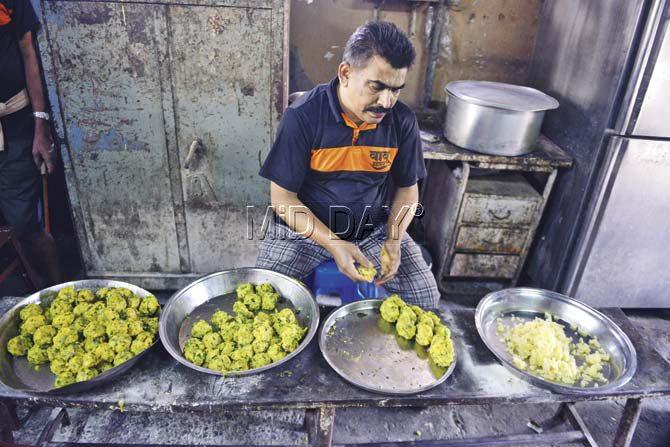
A worker at Babu Vada Pav at Vile Parle rolls the vada. Every three days, they utilise 600 kg of potatoes. Pics/Khushnum Bhandari
I have signed up for a Vada Pav Food Walk with experiential company, Blue Bulb and this is the ideal place to start. Food blogger Abhishek Sadekar, a resident of Vile Parle East, tells me about the history of vada pav, how it evolved into Mumbai’s favourite snack and the various iconic joints that serve it.
ADVERTISEMENT
Get your hands dirty
We step into the dimly-lit kitchen, where I will get to make my own vada pavs. On my left, a worker is deep-frying vadas in a huge pan while on my right, another man is mixing thencha — a mixture of ginger, curry leaves, green chillies, coriander, salt, turmeric and black gram flour and mustard seeds in oil — into a big container of mashed potato.

The writer tries her hands at rolling and frying vadas (right) Babu Vada Pav stall
Having gorged on various vada pavs across Mumbai and Maharashtra, this is the first time I have entered a kitchen. While the workers prepare the ingredients, Sadekar takes me through a brief history of the vada pav, which was first served at a joint in Dadar in 1970. “While the batata vada, which is mixed with turmeric, salt, ginger- chilli paste, is typically a Maharashtrian delicacy, the pav has been borrowed from the Christians,” says Sadekar, handing over a pair of gloves to me.
I slip them on and settle on a blue plastic stool across a low wooden bench. One of the workers scoops a handful of aloo masala and rolls it into a ball using just one hand. He skillfully rotates the ball in his palm and shapes it into a perfect round. When it’s my turn, I can barely roll it using just one hand and take the leeway to use both. Thankfully, my vadas are almost perfect. He then shows me how to flatten each of them before they are ready to be fried.
The oil is bubbling hot in the pan and another worker shows me how to mix the hand-rolled aloo vadas in the chrome yellow besan batter and gently slide them into the oil. I dunk one into the sticky paste and slip it into the oil.
Next, Sadekar guides me to the stall outside to assemble my vada pavs. The fresh pav, I am told, comes from a bakery in Andheri five times a day. When I ask the owner how many vada pavs do they sell in a day, he says he stopped counting years ago, though they replenish their 600-kg potato sacks every three days.
As the impatient buyers waiting at the stall for their order look on, I spread a generous layer of mint chutney on the pav, top it with sweet date and tamarind chutney and sprinkle dried garlic powder and pack in the vada.
The pungent taste of curry leaves, intermingled with garlic, ginger, coriander hits my mouth as I bite into the vada pav I prepared. “The green chutney usually activates your lower palate — the tongue — while the red chutney works on the upper palate,” Sadekar explains, who shares with me the secret behind the dried garlic powder. “It’s nothing but the small crispies that are found in the frying pan. They are crushed and mixed with salt, garlic and red chilli powder,” he says.
Babu bhai, who opened the canteen in 1950 after working as a table boy and helper in the nearby Jeevan restaurant, eagerly hands us a plate of patti samosas, his next best item. The filling comprising green pea, garam masala and red chillies, is wrapped in thin pastry sheets. Having eaten the Punjabi samosas often, this taste is rather unique, thanks to its paper-thin crust and fiery filling.
To soothe our palates, we stop at Panshikar’s, where we try Awla and Ginger lemon drinks. While the former is sweet, which is the need of the hour, the latter is rather pungent.
Shegaon Chi Kachori
We make our way to a kachori shop called Shegaon Chi Kachori, inspired by the dish of the same name from saint Shree Gajanan Maharaj’s town, Shegaon. It is also believed that Vile Parle station gets its name from two temples — Virleshwar and Parleshwar.
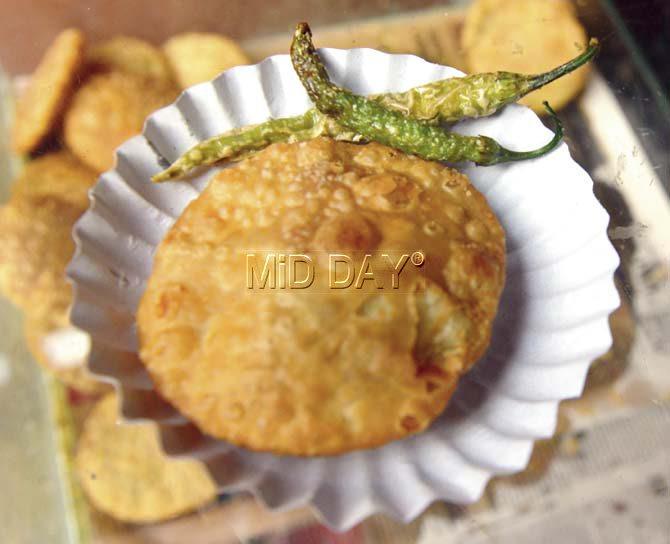
Shegaon Chi Kachori is mixed with gram flour and black gram flour
The areas were earlier divided into Idli Padli and are today known as Irla and Parle.
Originally it saw Gujarati and Christian settlers. Later, Maharashtrians also relocated to this suburb. Coming back to the kachori, it is flat, thick and has a crispy outer covering. Inside is a well-ground and spicy paste of gram flour (besan) and black gram flour (udad dal). Medium spicy, the filling does not burst firecrackers on the palate yet it leaves a lasting taste. It is the work of the Maharashtrian garam masala.
Chhaan Chavdaar
We walk off Hanuman Road, which primarily divides Vile Parle East into two sections and walk toward Chan Chavdaar, which is run by Palomi Mahila Sanstha.
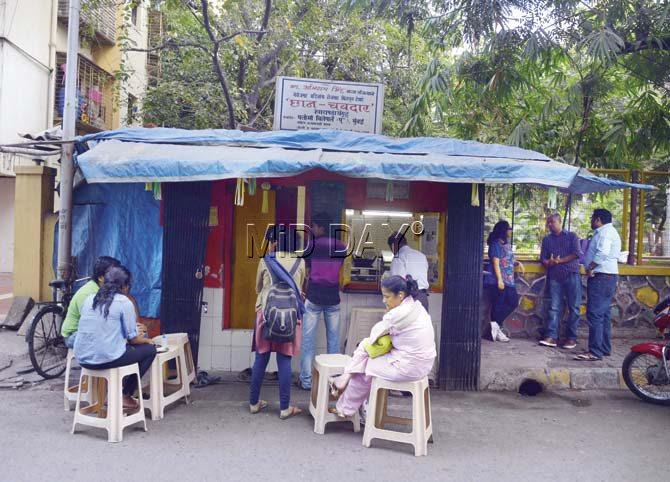
Chhaan Chavdaar is a home-cooked style eatery on Malviya Road near Sathe College, Vile Parle East
It’s easy tomiss this hole-in-the-wall eatery, which serves home-cooked style Maharashtrian snacks including, Ussal, Misal Pav, Vada Pav and Kothimbir Vadi. Compared to the overpowering flavour of curry leaves in the vada pav at Babu Vada Pav, the one served here is milder. The unevenly mashed aloo mixture lends it a fuller texture while the outer cover is crispier. The sweet chutney is more flavoursome and the tangy taste of tamarind uplift the melt-in-the-mouth experience.
Parleshwar Vada Pav Samrat
After satiating our appetite, we head to our last stop, Parleshwar Vada Pav Samrat on Nehru Road. The most popular vada pav joint in the vicinity, it serves a variety of vada pavs, including a Chinese Vada Pav, which is served with Schezwan sauce.
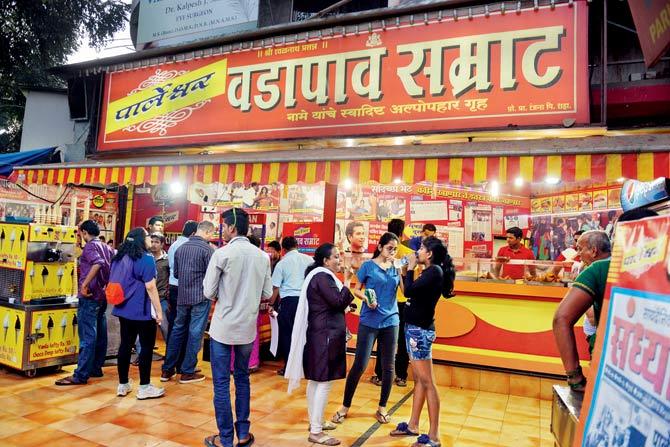
Parleshwar Vada Pav Samrat even serves Chinese Vada Pav
Despite being a tad bit cold, the kanda bhajji (Onion fried in gram flour batter) is crispy. The vada pav is the biggest among all the ones that we have tasted till now and the filling is perfectly spiced.
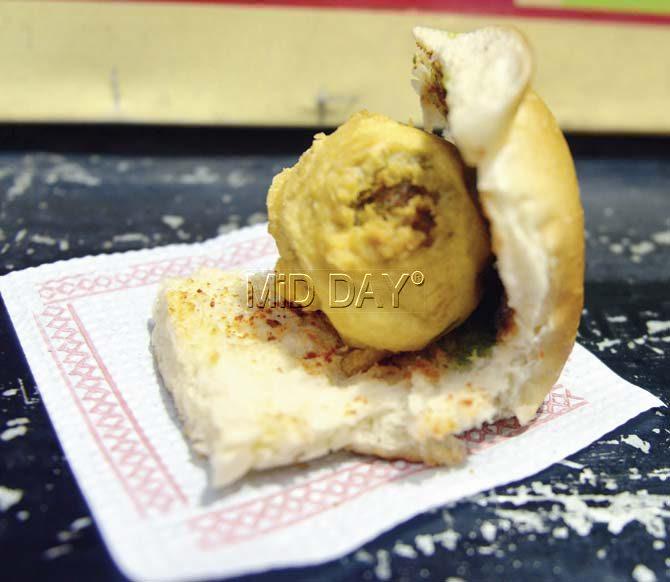
We end our walk outside Prabhu Kripa, which sells Maharashtrian snacks such as Puran Poli, chivda and laddoos. Alone, I walk a little more through the vegetable market, soaking in the hustle bustle of vegetables vendors. The lingering aftertaste of curry leaves keeps me company.
To participate, call: 32270033
 Subscribe today by clicking the link and stay updated with the latest news!" Click here!
Subscribe today by clicking the link and stay updated with the latest news!" Click here!







